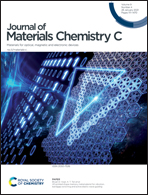Improved anisotropy and piezoelectricity by applying in-plane deformation in monolayer WS2†
Abstract
Two-dimensional (2D) piezoelectric materials are mechanically flexible and atomically thin, enabling new emerging applications, such as wearable electronics, human–machine interfacing and strain sensors. The main obstacles for 2D piezoelectric materials are their low in-plane polarization and weak piezoelectric effect. In this study, we found piezoelectric effect in monolayer WS2 for the first time. Further, the in-plane uniaxial deformation was applied along the polarized armchair direction of WS2, giving rise to an enlarged in-plane polarization as evidenced from the higher Raman anisotropy of angle-resolved polarized Raman spectra. As a result, engineered WS2 exhibited a significantly improved dynamic piezoelectric signal by almost one order of magnitude. This study demonstrates a new strategy to artificially engineer monolayer WS2 by applying in-plane deformation for the larger anisotropy, higher polarization and more superior piezoelectricity, which can open up a new way for applications in 2D-based piezotronics and angle-dependent electronics.



 Please wait while we load your content...
Please wait while we load your content...